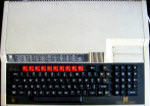The BBC Master was released by Acorn Computers in early 1986. It was designed as the successor to the BBC Micro Model B. The Master featured several improvements on its predecessor. The systems had 128 KB RAM as standard, to make it easier to use the best graphics modes. It had two cartridge slots mounted above the numerical keypad. Rather than the MOS Technology 6502 microprocessor used by the Model B it ran on the slightly improved 65C102: the cost of this CPU compatibility with the Model B was that the address bus was still only 16 bits, meaning that only 64 KB could be direct addressed at any one time and the remaining memory had to be paged in as required. However the 65C102's extra instructions allowed a little more to be shoehorned into the OS and BBC BASIC ROMs, limited by the memory architecture to 16 KB each.
|



|
Specifications
¤ 2 MHz Rockwell R65C102 processor
¤ 128 KB ROM, consisting of 16 KB MOS (Machine Operating System),
always accessible, and seven 16 KB ROMs,
any one of which could be paged into memory at a time:
¤ 16 KB BBC BASIC
¤ 16 KB Disk Filing System
¤ 16 KB Advanced Disk Filing System
¤ 16 KB Acornsoft View (word processor)
¤ 16 KB ViewSheet (spreadsheet)
¤ 16 KB Acorn Screen Editor AKA Edit (text/BBC BASIC editor)
¤ 16 KB MOS extras (such as the cassette filing system)
¤ 128 KB RAM, comprising:
¤ 32 KB main user program/data storage
¤ 20 KB "shadow" video memory (paged over main user RAM)
¤ 12 KB OS workspace (paged over main user RAM)
¤ 64 KB workspace accessible to user machine code applications
(in four 16 KB "Sideways" blocks any one of which could be paged
into memory if BBC BASIC the other paged ROMs not required)
¤ Full-travel keyboard with a top row of ten red-orange function keys
f0 - f9 and AT-style numeric keypad
¤ Highly configurable graphics display based on the Motorola 6845.
unlike on the original BBC Micro, separate video RAM was used.
¤ Four independent sound channels (one noise and 3 melodic)
using the Texas Instruments SN76489 sound chip
|
Graphic resolutions
Mode Resolution Hardware Colours Video RAM
Char cells (X-Y)Pixels
0 80 × 32 640 × 256 2 20 Graphics
1 40 × 32 320 × 256 4 20 Graphics
2 20 × 32 160 × 256 8 20 Graphics
3 80 × 25 640 × 200 2 16 Text
4 40 × 32 320 × 256 2 10 Graphics
5 20 × 32 160 × 256 4 10 Graphics
6 40 × 25 320 × 200 2 8 Text
7 40 × 25 240 × 250 8 1 (Teletext) Text
Built-in hardware support
¤ pluggable ROMs, directly or via cartridge slots
¤ floppy disk drives (DFS and ADFS) WD1770 disk controller
¤ tape interface (with motor control),
¤ Centronics parallel printer
¤ serial communication (using RS-423, a superset of RS-232)
¤ display output for TV, RGB or 1v p-p video monitor
¤ A 15 pin 'D shaped' port with four analogue inputs
(suitable for joysticks, four digital/contact ports (for buttons)
and a special Light pen input, and
¤ proprietary "Tube" interface for internal or external 2nd CPU
¤ a 16 pin IDC style "user port"
consisting of 8 general purpose digital I/O pins
¤ generic expansion through the "1 MHz bus".
¤ Econet interface, by adding a module board and ANFS ROM.
|
